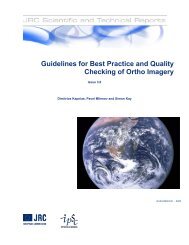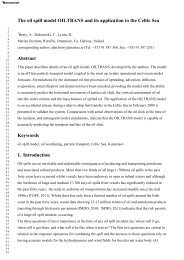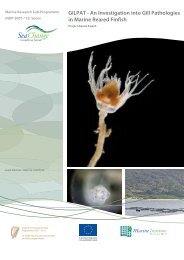Case Study 3: Shoal Project – Autonomous ... - Marine Institute
Case Study 3: Shoal Project – Autonomous ... - Marine Institute
Case Study 3: Shoal Project – Autonomous ... - Marine Institute
You also want an ePaper? Increase the reach of your titles
YUMPU automatically turns print PDFs into web optimized ePapers that Google loves.
SMART Ocean Ireland<br />
“Towards a New Horizon Harnessing<br />
Ireland’s Potential as a European and<br />
Global Centre for Ocean Technology”<br />
March 22/23, 2010<br />
Session 2: Environment: Sensing,<br />
Communication and Forecasting<br />
<strong>Case</strong> <strong>Study</strong> 3:<br />
<strong>Shoal</strong> <strong>Project</strong> – <strong>Autonomous</strong><br />
Pollution Sensing in the <strong>Marine</strong><br />
Environment<br />
Dr. Cian Ó Mathúna<br />
Head of Microsystems Centre<br />
Tyndall National <strong>Institute</strong><br />
University College Cork,<br />
Cian.omathuna@tyndall.ie<br />
www.tyndall.ie
Summary of Presentation<br />
• Tyndall National <strong>Institute</strong><br />
• Wireless Sensors for<br />
Water Quality Monitoring<br />
• <strong>Autonomous</strong> Wireless Sensors Networks<br />
“Deploy and Forget”<br />
“The Sensor Web”<br />
• EU FP7 SHOAL <strong>Project</strong><br />
www.tyndall.ie
• Largest ICT research institute in Ireland:<br />
– Photonics, Microelectronics.<br />
– Nanotechnology, Microsystems.<br />
• Only 3 rd- level silicon fabrication facility.<br />
• Critical mass of researchers/facilities:<br />
– 400+ staff (120 graduate students).<br />
– €200m capital investment.<br />
– €30m annual turnover.<br />
– October 2009 – New €50m facility.<br />
• Applications – Communications, Energy,<br />
Health, Environment.<br />
• Strategic national/international partnerships.<br />
Tyndall National <strong>Institute</strong><br />
“From Atoms to Systems ……<br />
…… Generating Value from Research for Ireland”<br />
www.tyndall.ie
SMARTCOAST/DEPLOY (EPA/MI)<br />
November 19/20 th , 2009 www.corkfloodwatch.com<br />
www.tyndall.ie
Inniscarra<br />
Reservoir x 2<br />
Deployment River Lee, Cork City<br />
Lee<br />
Road<br />
Tyndall @<br />
Lee<br />
Maltings<br />
Tivoli<br />
Docks<br />
www.tyndall.ie
<strong>Autonomous</strong> River Depth Measurements<br />
€250million flood damage<br />
Live depth data (Deploy <strong>Project</strong>)<br />
& video streaming<br />
(Edel O’Connor, Alan Smeatonm, DCU).<br />
Providing data in real time for monitoring and<br />
analysis.<br />
www.tyndall.ie
• <strong>Autonomous</strong> sensors:<br />
- Interface to physical world.<br />
- Embedded intelligence.<br />
- Miniaturised.<br />
- Wireless communications, Networked.<br />
- Self-powered.<br />
• Key Research Challenges:<br />
– Miniaturised, robust packaging.<br />
– Energy harvesting.<br />
– Low cost, high volume manufacturable.<br />
– Massive scaleability.<br />
– Self cleaning chemo/bio-sensors.<br />
Microsystems Grand Challenge<br />
“deploy and forget”<br />
“Cost nothing, Take up no Space, Last forever”<br />
www.tyndall.ie
SFI CLARITY CSET<br />
“The Sensor Web”<br />
• bringing information to life.<br />
• focus on the ‘Sensor Web’.<br />
• captures the intersection between Adaptive Sensing<br />
and Information Discovery.<br />
• Applications:<br />
– Environment – Water and Air Quality.<br />
– Health and Fitness - Wearable Electronics.<br />
– Energy monitoring in the home.<br />
• €16m Budget over 5 years.<br />
www.tyndall.ie
Search and monitoring of Harmful contaminants, Other pollutAnts<br />
and Leaks in vessels in port using a swarm of robotic fish.<br />
<strong>Project</strong> Budget: €4.23M<br />
SHOAL @ Tyndall<br />
Instrumentation and software: Dr. Vladimir Ogurtsov.<br />
Chemical Sensors: Dr. Grégoire Herzog.<br />
FP7 SHOAL<br />
2009-2012<br />
FP7 ICT-231646
To design and develop three fully functional<br />
robotic fish equipped with chemical sensors<br />
and a scalable communications<br />
infrastructure.<br />
1. Each robotic fish will detect pollution with<br />
on-board electrochemical sensors.<br />
2. Underwater communications between<br />
fish and to the hub located on-shore.<br />
3. Swarm intelligence will allow the fast and<br />
accurate localisation of the pollution source.<br />
4. Results transferred to Port Authority in<br />
real time.<br />
Objective and Strategy
Robotic Fish Architecture<br />
Based on existing prototypes, the consortium will develop a new<br />
generation of robotic fish that can operate autonomously in the port<br />
to search and monitor harmful contaminants cooperatively.
Development of portable and intelligent chemical<br />
sensing system capable of autonomous operation<br />
on board the robotic fish:<br />
• Electrochemical sensors for marine<br />
pollutants and seawater quality in real-time<br />
(heavy metals and phenol derivatives,<br />
dissolved oxygen concentration, seawater<br />
conductivity and the oxido-reduction<br />
potential).<br />
• On-board instrumentation.<br />
• Intelligent signal processing and data<br />
interpretation algorithms capable of operation<br />
in autonomous mode.<br />
Tyndall’s Role
Field trials will take place in 2012 in the Port of Gijón in Spain.<br />
Two locations in the Port have<br />
been selected to hold the field<br />
trials. They have been selected<br />
regarding certain parameters<br />
(underwater current, vessel<br />
movement, access to the<br />
sea…)<br />
Final field trials
• Tyndall a strategic partner in next<br />
generation wireless sensor technology.<br />
Conclusions<br />
• <strong>Autonomous</strong> wireless sensor networks<br />
require development of “deploy and forget”<br />
systems and the integration with the<br />
“sensor web”.<br />
• Ireland’s opportunity: clustering across the<br />
supply chain/value of research and<br />
industry (SMEs and MNCs).

















